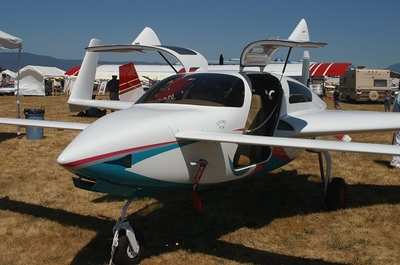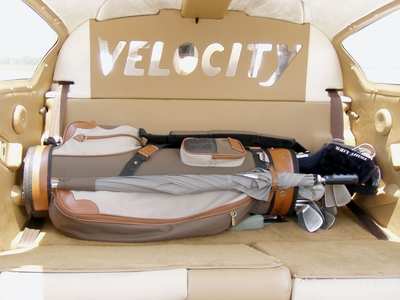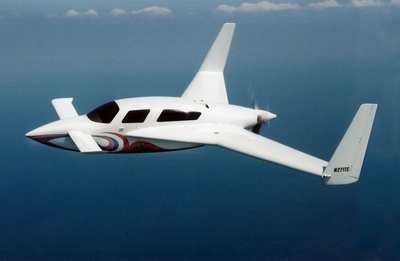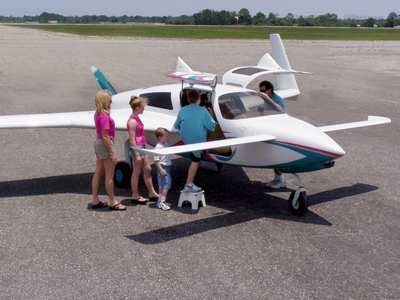...Or Loads Of Baggage
 You're not going to find a much
bigger fan of the Velocity XL series than yours truly. A few years
back, I flew one about 2000 miles over the course of a day in which
I had to battle being vectored into one humongoid thunder-bumper
(and putting a hell of a dent in the ceiling with my noggin), an
unwelcome back-course ILS into Baton Rouge, and playing hide and
seek with B-1s over TX. It was a surprisingly good trip despite all
that, and ample proof that the Velocity breed is a stout and stable
series of birds... and one of my favorites for getting around the
country.
You're not going to find a much
bigger fan of the Velocity XL series than yours truly. A few years
back, I flew one about 2000 miles over the course of a day in which
I had to battle being vectored into one humongoid thunder-bumper
(and putting a hell of a dent in the ceiling with my noggin), an
unwelcome back-course ILS into Baton Rouge, and playing hide and
seek with B-1s over TX. It was a surprisingly good trip despite all
that, and ample proof that the Velocity breed is a stout and stable
series of birds... and one of my favorites for getting around the
country.

But... How do you improve on the Velocity XL? Duane Swing thinks
the answer to that question, at least for those with a need for a
little more room, is their new "Dash-V Edition." Velocity has kept
all the truly X-quisite features of the XL series... it's still
Xtra long, Xtra wide, has Xtra head room, an Xtra large engine,
Xtra fuel capacity, is Xtra fast, and Xtra easy to enter and
depart. It's all that, plus a few more "Xtra's."
An Xtra seat
The "Dash-V's" five-seat interior layout features two bucket
seats in the front and a single rear bench seat with enough room
for two adults and one child (2+3). The curvature of the fuselage
gives the back seat passengers an extra-wide 49" of total hip room,
with as much as 50" of shoulder width. And if you have one rear
seat passenger who is a bit on the Xtrawide side themselves, the
rear bench seat is comfortably roomy for one!
Xtra baggage space
Behind the back seat is an extra-large baggage platform,
measuring 18" deep by the full width of the fuselage, 48".

Xtra packing versatility
Need to pack a golf bag? The seat back of the rear bench seat is
split 60/40, with each section able to be folded forward, providing
versatile loading configurations for large baggage. Velocity's
Scott Baker tells us that this aircraft can comfortably carry 3
adults and 3 sets of golf equipment! Or, if just two are
travelling, both rear seat sections can be folded forward, offering
an extra-extra-large area (50" deep x 48" wide) as a baggage
platform behind the pilot and copilot seats.
Xtra passenger comfort
The rear seat back also features a deluxe armrest that is stowed
in the center of the seat back. The armrest can be folded down into
position, like in many automobile rear seats, providing a
comfortable elbow rest when there are two rear passengers.
The center keel of the Dash-V is cut down to within three inches
of the floor, allowing the back seat passengers ease of entry plus
lots of leg room. The kit option comes with a reinforced keel cap
and a drop-down aileron control mechanism.

Xtra load bearing
The main landing gear legs are wrapped with carbon fiber BID
reinforcements at the factory, to accommodate the expected heavier
loads of the aircraft over the main wheels.
Xtra engine power, Xtra braking power
A 300 hp Lycoming or 310 hp Continental can be selected to power
the Dash-V aircraft. The gross weight of the aircraft is increased
to 2,900 pounds with either of these engine choices - a 200-pound
increase in useful load compared with the Velocity XL with a 260hp
engine. Heavy-duty Cleveland brakes are provided with this kit
option to accommodate the heavier gross weight of the aircraft.
Xtra Rudders
A new dual, interconnected, rudder pedal assembly, with toe
brakes, comes standard with the Dash-V option. This allows full
rudder deflection during crosswind landings, without worrying that
the brakes are engaged.

As an option to the existing Velocity XL, the Dash-V Edition is
available on both the fixed-gear or retract-gear versions. The
introductory price of the "Dash-V Edition" option is $3,000, and is
immediately available for new Velocity XL kit buyers.
Velocity will also offer a "Dash-V" retrofit kit for Velocity XL
owners in the field, at a cost of $3,500. Special Dash-V
components, such as the Cleveland brakes, toe-brake pedal assembly,
and drop down keel, will also be available as individual
subassembly options.
See It At The "Big-O"
As we saw at Arlington, Velocity's new factory-built demo
airplane, N271TC, is a magnificent construct. This bird is packed
to the rafters (do Velocity's have rafters? I must ask Duane...)
with the latest state-of-the-art pilot toys and goodies.

Among the many attributes of this deluxe demo bird, you'll see a
Continental 310hp engine with PowerLink FADEC
(Full Authority Digital Engine Control) Engine Power Management
System. A multitude of sensors sends engine information to three
computers, which then analyze and adjust the ignition spark, engine
timing, and fuel delivery to each of the six cylinders, maximizing
performance. The system allows the pilot to select best power
or best economy. Mixture control is eliminated. The system is
electrically operated and does not require the use of magnetos for
ignition (there are no magnetos on the engine). PowerLink FADEC
promises a 15% improvement in fuel economy and about a 5% increase
in power. This is the first Velocity aircraft powered with a FADEC
system. Five Velocity customers have already purchased Continental
FADEC engines through Velocity's OEM buying program.
Dual Large Screen "Glass Cockpit" EFIS Display Units
Manufactured by Blue Mountain Avionics, the EFIS/One system (www.bluemountainavionics.com)
provides a full display of flight information including attitude
information, heading information, a moving map, air speed, rate of
climb, turn coordinator, altimeter, true air speed, trend meters
for airspeed and altitude readouts and a host of information
that are too numerous to list in a single page! For the demo
aircraft, the factory installed a second display, so guests can
experience the same full EFIS sensation that is offered the demo
pilot. The EFIS/One comes with an optional autopilot sub-assembly,
with climb, descent, and altitude hold capability.
WSI In-Flight Cockpit Weather
The demo aircraft has a WSI satellite receiver to collect and
process a full menu of aviation weather information. For less than
$50/month, pilots have unlimited in-flight access to weather
reporting products such as composite radar images, thunderstorm
tops, METARs, TAFs, a color graphic depiction of airports based on
their current weather reporting status (IFR or VFR), and more. The
WSI system integrates with several display units including the Blue
Mountain Avionics EFIS/One and the UPSAT MX-20MFD. All from outer
space and updated every 6 seconds!
 ANN's Daily Aero-Term (05.05.25): Circle To Runway (Runway Number)
ANN's Daily Aero-Term (05.05.25): Circle To Runway (Runway Number) ANN's Daily Aero-Linx (05.05.25)
ANN's Daily Aero-Linx (05.05.25) NTSB Prelim: De Havilland DHC-1
NTSB Prelim: De Havilland DHC-1 Classic Aero-TV: The Boeing Dreamliner -- Historic First Flight Coverage
Classic Aero-TV: The Boeing Dreamliner -- Historic First Flight Coverage Airborne-NextGen 05.06.25: AF Uncrewed Fighters, Drones v Planes, Joby Crew Test
Airborne-NextGen 05.06.25: AF Uncrewed Fighters, Drones v Planes, Joby Crew Test







